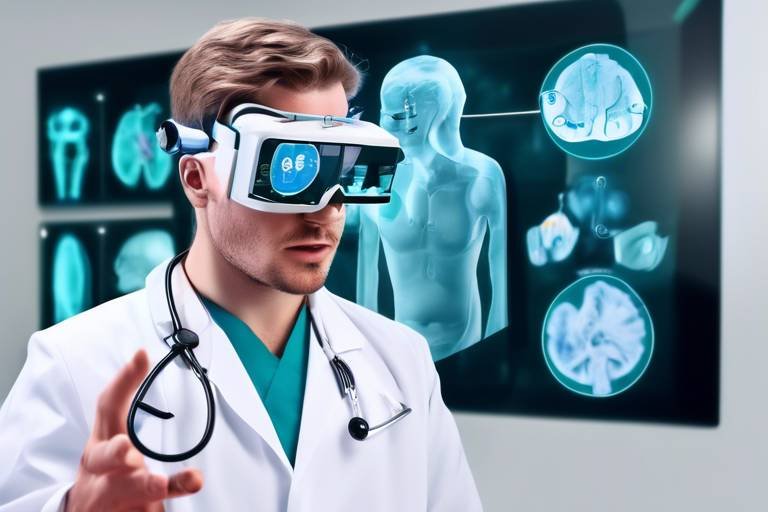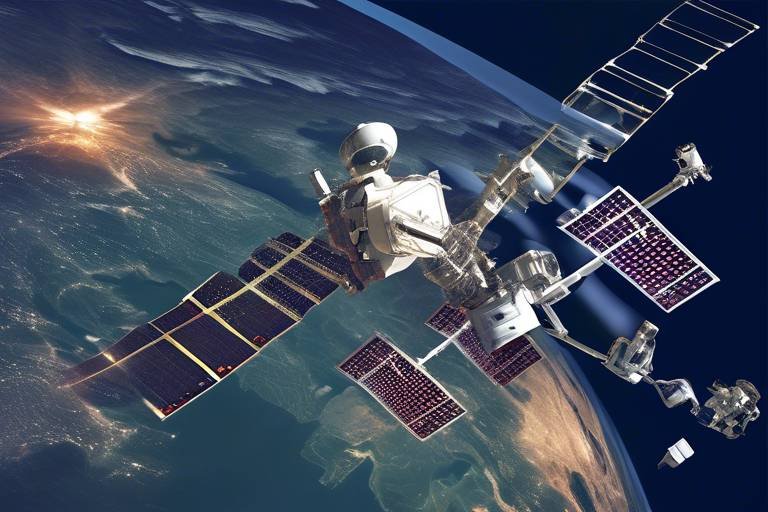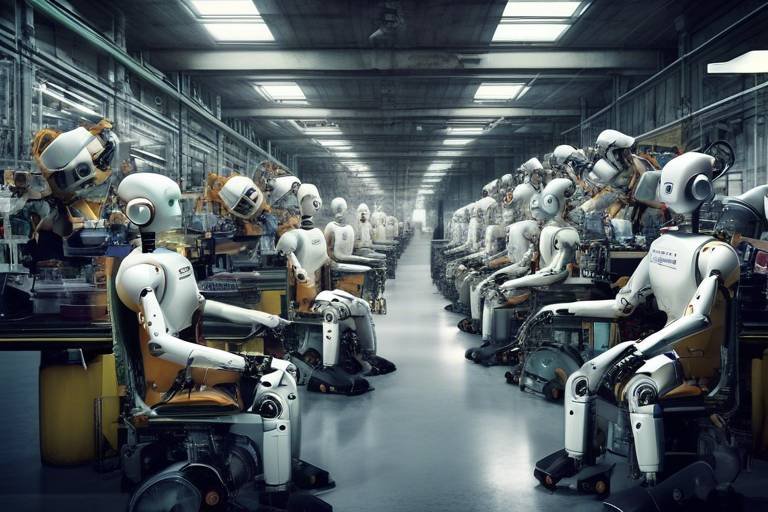The Future of Space Mining - Extracting Resources from Asteroids
Have you ever gazed up at the night sky and wondered what lies beyond our blue planet? The cosmos is not just a vast expanse of stars and planets; it's a treasure trove of resources waiting to be discovered. Enter the exciting world of space mining, a groundbreaking field that promises to revolutionize how we acquire essential materials. Imagine a future where we extract valuable metals and minerals from asteroids, potentially solving many of Earth's resource shortages. This article explores the emerging field of space mining, focusing on the potential of asteroids as resource-rich bodies that could revolutionize resource acquisition and sustainability on Earth.
Asteroids, often seen as mere rocks floating in space, are actually remnants from the solar system's formation. They are composed of various materials, including metals like nickel, iron, and precious minerals such as platinum and gold. These celestial bodies are categorized into different types based on their composition:
- C-type (carbonaceous): Rich in organic compounds and water, making them potential sources for life-supporting materials.
- S-type (silicaceous): Composed mainly of metal and silicate minerals, ideal for extracting metals.
- M-type (metallic): These are primarily made of metal and are considered the most valuable for mining operations.
Their unique compositions not only make asteroids intriguing but also present opportunities for resource extraction that could significantly impact our planet's economy and sustainability.
To tap into the vast potential of asteroids, we need cutting-edge technology. The challenges of space mining are immense, but so are the innovations. From advanced robotics to sophisticated remote sensing techniques, the tools we develop today will pave the way for successful asteroid mining in the future. The efficiency of these technologies will determine how quickly and effectively we can extract resources from these distant bodies.
Robots are the unsung heroes of space mining operations. They are designed to operate in the harsh conditions of space, performing tasks that would be impossible for humans. Recent advancements have led to the development of autonomous robotic miners that can navigate, analyze, and extract materials without direct human intervention. These robots utilize artificial intelligence to make real-time decisions, ensuring that mining operations are both efficient and safe.
Before we can mine an asteroid, we must first identify which ones are worth the effort. This is where remote sensing comes into play. Using advanced imaging technologies, scientists can survey and analyze asteroids from a distance, assessing their composition and potential yield. Techniques such as spectroscopy and radar mapping allow researchers to gather crucial data, helping to pinpoint the most promising targets for mining missions.
Once a resource-rich asteroid has been identified, the next step is extraction. The methods for drilling and extracting materials from asteroids are evolving rapidly. Innovative technologies, such as laser drilling and thermal extraction, are being developed to ensure that we can efficiently collect resources with minimal waste. These methods not only enhance extraction rates but also reduce the environmental impact of space mining operations.
Various space agencies and private companies are already planning missions to mine asteroids. For instance, NASA's OSIRIS-REx mission has successfully collected samples from the asteroid Bennu, while companies like Planetary Resources and Deep Space Industries are developing their own mining technologies. These missions are not just about exploration; they represent the first steps towards a new era of resource acquisition that could eventually lead to sustainable practices on Earth.
The economic potential of space mining is vast. Imagine a world where the scarcity of rare metals is a thing of the past, where industries no longer face supply chain disruptions due to resource shortages. Asteroid mining could drastically change the game, impacting global markets and resource availability. The prospect of accessing billions of dollars worth of materials from asteroids has investors buzzing with excitement.
Understanding the financial aspects of space mining is crucial. While the initial investment in technology and missions can be substantial, the potential profits from extracted resources are enormous. A comprehensive cost-benefit analysis reveals that the long-term gains from asteroid mining could far outweigh the costs, making it a lucrative venture for both governments and private enterprises.
The demand for rare metals and minerals is on the rise, driven by advancements in technology and the ever-growing need for sustainable energy solutions. Space mining could meet this demand, reshaping industries on Earth. For instance, the extraction of platinum from asteroids could revolutionize the automotive and electronics industries, providing a sustainable source of materials that are currently in limited supply.
As we venture into the realm of space mining, we must also navigate the complex legal and ethical landscape that comes with it. Questions surrounding ownership, resource rights, and environmental responsibilities are at the forefront of discussions among policymakers and scientists alike. Establishing a regulatory framework that addresses these concerns is essential to ensure that space mining benefits all of humanity.
International agreements govern space activities, but the current legal landscape regarding asteroid mining is still evolving. The Outer Space Treaty, established in 1967, outlines that no nation can claim sovereignty over celestial bodies. However, as technology advances and space mining becomes a reality, new regulations will be needed to address ownership and resource extraction rights.
The ethics of exploiting extraterrestrial resources are complex. We must consider the implications of our actions on future generations and the potential consequences of depleting resources from space. Are we prepared to take on the responsibility of managing these resources sustainably? The moral considerations surrounding space mining will shape the policies and practices we adopt as we move forward.
- What are asteroids made of? Asteroids are primarily composed of metals, silicates, and sometimes organic compounds, making them rich in valuable resources.
- How do we mine asteroids? Mining asteroids involves using advanced robotic technology, remote sensing techniques, and innovative extraction methods.
- What are the economic benefits of space mining? Space mining could provide a sustainable source of rare metals, reduce reliance on terrestrial mining, and create new industries and jobs.
- Are there legal regulations for space mining? Currently, international space law is evolving to address ownership and extraction rights for celestial bodies.

Understanding Asteroids
Asteroids are fascinating remnants from the early days of our solar system, offering a glimpse into the building blocks that formed the planets. These rocky bodies, primarily located in the asteroid belt between Mars and Jupiter, are not just space debris; they are treasure troves of valuable metals and minerals. Imagine stumbling upon a hidden chest filled with gold and silver, but instead, it’s floating in space! This section delves into the composition of asteroids and the types of resources they harbor, which could potentially revolutionize our approach to resource acquisition.
Asteroids can be broadly classified into three types based on their composition:
- C-type (Carbonaceous): These are the most common type, making up about 75% of known asteroids. They are rich in carbon and contain water, making them potential candidates for future resource extraction.
- S-type (Silicaceous): Comprising around 17% of asteroids, S-types are primarily made of silicate minerals and nickel-iron. They are particularly interesting for mining due to their metallic content.
- M-type (Metallic): These asteroids are composed mainly of metallic iron and nickel. They are rarer but hold immense potential for mining operations, as they could yield significant quantities of precious metals.
Each type of asteroid presents unique opportunities for resource extraction. For instance, C-type asteroids may provide water, which is essential for sustaining human life during long missions in space. S-type and M-type asteroids, on the other hand, are rich in metals like platinum, gold, and rare earth elements. The potential for extracting these resources cannot be overstated, as they are crucial for various industries on Earth, including technology, renewable energy, and even construction.
In addition to their composition, the size and location of asteroids also play a vital role in assessing their viability for mining. While some asteroids are as small as a few meters across, others can be several hundred kilometers in diameter. The larger asteroids are particularly appealing because they contain more resources, making them more economically viable for extraction. Moreover, their orbits can be relatively close to Earth, reducing the costs associated with space travel and making missions more feasible.
As we look to the future, understanding the characteristics of asteroids is essential for developing effective mining strategies. Not only do we need to know what resources are available, but we also have to consider how to access them efficiently and safely. This involves a combination of innovative technology and strategic planning, paving the way for a new era of space exploration and resource acquisition.

Technological Innovations in Space Mining
The realm of space mining is not just a distant dream anymore; it's becoming a reality thanks to technological innovations that are reshaping our understanding of resource extraction beyond Earth. Imagine a future where we can tap into the vast resources of asteroids, and the key to this future lies in the groundbreaking technologies being developed today. These innovations are not merely enhancements; they represent a paradigm shift in how we approach the challenges of extracting valuable materials from these celestial bodies.
One of the most exciting developments in space mining technology is the rise of robotic mining equipment. These advanced machines are designed to operate in the harsh environments of space, where human presence is limited. Equipped with artificial intelligence and autonomous capabilities, robotic miners can navigate the rugged terrain of asteroids, collect samples, and even process materials on-site. This reduces the need for transporting raw materials back to Earth, significantly cutting down costs and increasing efficiency.
Robotic miners are the backbone of any successful space mining mission. They are engineered to withstand extreme temperatures, radiation, and microgravity conditions. For instance, companies like Planetary Resources and Deep Space Industries are pioneering the development of these robots, which can perform tasks ranging from drilling to material processing. The ability to operate autonomously not only enhances safety but also allows for continuous mining operations, maximizing output.
Before we can send these robots to an asteroid, we need to know where to look. This is where remote sensing techniques come into play. By utilizing advanced imaging technologies, scientists can survey and analyze asteroids from afar. Instruments like infrared spectrometers and radar systems help identify the composition of asteroids, revealing their potential resource wealth. This data is crucial for planning missions and ensuring that we target the most promising candidates for mining.
Once a suitable asteroid is identified, the next challenge is extracting its resources. Current drilling technologies are being adapted for space use, focusing on efficiency and reliability. Techniques such as laser drilling and mechanical excavation are being explored. These methods are designed to minimize the disruption of the asteroid's surface while maximizing the yield of valuable materials. For example, laser drilling can vaporize material, making it easier to collect, while mechanical methods may involve the use of specialized drills that can penetrate the hard surfaces of asteroids.
As we look to the future, the integration of these technologies will not only enhance our ability to mine asteroids but also pave the way for sustainable resource management on Earth. By tapping into extraterrestrial resources, we can alleviate some of the pressures on our planet's dwindling reserves. The implications of these innovations are vast, opening doors to new industries and economic opportunities that were once thought to be the stuff of science fiction.
In conclusion, the technological advancements in space mining are nothing short of revolutionary. As we continue to innovate and refine these tools and techniques, the dream of extracting resources from asteroids is becoming increasingly achievable. The future holds exciting possibilities, and with the right investments and research, we may soon see the first successful space mining operations, heralding a new era of resource acquisition.
- What are the primary resources found in asteroids? Asteroids are rich in metals such as platinum, gold, and rare earth elements, as well as water, which can be converted into fuel.
- How do robotic miners work in space? Robotic miners use AI and autonomous systems to navigate, drill, and process materials in harsh space environments.
- What are the challenges of space mining? Key challenges include the high cost of space missions, the need for advanced technology, and the harsh conditions of space.
- Are there any current space mining missions? Yes, several private companies and space agencies are planning missions to explore and mine asteroids in the coming years.
- What is the potential impact of space mining on Earth? Space mining could provide new resources, reduce dependency on Earth's natural reserves, and drive economic growth in new industries.

Robotic Mining Equipment
When it comes to the thrilling world of space mining, robotic mining equipment stands at the forefront of innovation. Imagine a fleet of highly advanced robots, equipped with the latest technology, zipping around asteroids, meticulously extracting precious resources. This is not just science fiction; it’s the reality that scientists and engineers are working towards today. These robots are designed to handle the harsh conditions of space, operating in environments that would be utterly inhospitable to humans.
One of the most exciting aspects of robotic mining is the ability to deploy them remotely. This means that while we’re comfortably on Earth, these machines can be tirelessly working on asteroids millions of miles away. They can be programmed to perform complex tasks such as drilling, analyzing mineral compositions, and transporting materials. The precision and efficiency of these robots are unparalleled, allowing for a level of resource extraction that was previously unimaginable.
Several key technologies are driving the development of robotic mining equipment:
- Autonomous Navigation: Robots are equipped with advanced sensors and AI algorithms that allow them to navigate the unpredictable terrain of asteroids without human intervention.
- High-Precision Drilling: Utilizing cutting-edge drilling technology, these robots can penetrate the asteroid's surface to extract valuable materials with minimal disturbance.
- Real-Time Data Analysis: Equipped with onboard analytical tools, robots can assess the composition of the materials they extract, ensuring that only the most valuable resources are brought back.
Moreover, the integration of machine learning allows these robotic systems to improve their efficiency over time. They can learn from previous missions, adapt to new challenges, and optimize their operations. This level of adaptability is crucial when dealing with the unpredictable nature of space environments.
As we look to the future, the development of robotic mining equipment will not only enhance our ability to extract resources from asteroids but will also pave the way for sustainable practices. By tapping into the vast resources available in space, we can reduce the strain on Earth's natural resources and move towards a more sustainable future. The potential benefits are enormous, and as technology advances, we are inching closer to making asteroid mining a reality.
In summary, robotic mining equipment is set to revolutionize the way we think about resource extraction. With their advanced capabilities, these machines will lead the charge in exploring and mining asteroids, ultimately changing the landscape of resource acquisition on Earth.
- What types of resources can be extracted from asteroids? Asteroids contain a variety of valuable metals and minerals, including nickel, iron, cobalt, and precious metals like gold and platinum.
- How do robotic miners operate in space? Robotic miners are equipped with autonomous navigation systems, high-precision drilling tools, and real-time data analysis capabilities, allowing them to operate independently on asteroids.
- What are the benefits of space mining? Space mining can alleviate resource scarcity on Earth, reduce environmental damage from mining practices, and provide a sustainable source of materials for future technologies.

Remote Sensing Techniques
When it comes to mining asteroids, one of the most critical steps is identifying which ones are worth the effort. This is where come into play. Imagine trying to find a needle in a haystack, only instead of hay, you're sifting through the vastness of space. Remote sensing allows scientists and engineers to gather data from asteroids without having to land on them, making it a game changer in the field of space mining.
Remote sensing involves using various technologies to collect information about an object from a distance. In the context of asteroids, this means employing instruments that can analyze their composition, size, shape, and even potential resource availability. Some of the most commonly used remote sensing techniques include:
- Spectroscopy: This method involves analyzing the light reflected off an asteroid to determine its mineral composition. Different materials absorb and reflect light differently, allowing scientists to identify valuable resources from millions of miles away.
- Radar Imaging: By sending radar waves to an asteroid and measuring the signals that bounce back, researchers can create detailed images of its surface. This technique helps in understanding the asteroid's structure and surface features.
- Infrared Thermography: This technique measures the heat emitted by an asteroid, providing insights into its surface materials and temperature variations. It can help identify areas that may contain ice or other resources.
These techniques not only assist in pinpointing resource-rich asteroids but also help map their trajectories and predict potential collisions with Earth. The data gathered through remote sensing can be incredibly detailed, often leading to the creation of comprehensive 3D models of asteroids. These models are crucial for planning future missions, as they allow scientists to simulate various mining scenarios and strategize accordingly.
Moreover, the integration of machine learning and artificial intelligence in remote sensing techniques is revolutionizing how we analyze the data. By processing vast amounts of information quickly, AI can identify patterns and make predictions that would take humans much longer to discern. This synergy between technology and space exploration is paving the way for a new era in resource extraction.
In summary, remote sensing techniques are the eyes and ears of space mining, providing critical insights that guide missions and maximize efficiency. As technology continues to advance, we can expect even more sophisticated methods to emerge, further enhancing our ability to explore and exploit the resources that asteroids have to offer.

Drilling and Extraction Technologies
The quest for resources from asteroids hinges significantly on the that are being developed today. Imagine a futuristic scene where robotic arms extend from a spacecraft, delicately tapping into the surface of a massive rock hurtling through space, extracting precious metals and minerals while avoiding catastrophic damage. This vision is not far from reality, as researchers and engineers are making groundbreaking strides in this field.
At the heart of these advancements are various drilling techniques that are being tailored specifically for the unique conditions of space. Unlike Earth, where we have the luxury of gravity and a stable environment, asteroids present a whole new set of challenges. For instance, the low gravity on these celestial bodies means that traditional drilling methods could lead to instability and inefficiency. To combat this, scientists are exploring innovative approaches such as vibration-assisted drilling and thermal drilling. Vibration-assisted drilling utilizes rapid oscillations to break through tough surfaces, while thermal drilling employs heat to melt the asteroid material, allowing for easier extraction.
Moreover, the materials used in constructing these drilling machines are crucial. Engineers are focusing on lightweight yet durable materials that can withstand the harsh conditions of space travel and the abrasive nature of asteroid surfaces. For example, advanced composites and alloys are being tested to ensure they can endure the rigors of repeated use without succumbing to wear and tear.
In addition to drilling, the extraction methods employed must be equally sophisticated. Once the drilling has created a pathway, the next step is to retrieve the valuable resources. Techniques such as robotic scooping and conveyor systems are being developed to facilitate the efficient collection and transport of mined materials back to the spacecraft. Some projects even envision the use of magnetic separation, where magnets are used to pull metallic resources from the asteroid's surface, minimizing contamination and maximizing yield.
To provide a clearer picture, here’s a brief overview of some of the most promising drilling and extraction technologies currently under development:
| Technology Type | Description | Advantages |
|---|---|---|
| Vibration-Assisted Drilling | Uses oscillations to break through surfaces. | Reduces energy consumption and increases efficiency. |
| Thermal Drilling | Melts asteroid material for easier extraction. | Effective on hard materials and minimizes debris. |
| Robotic Scooping | Mechanical arms scoop materials from the surface. | Allows for precise collection with minimal disturbance. |
| Magnetic Separation | Uses magnets to extract metallic resources. | High yield and low contamination risk. |
As these technologies evolve, they not only pave the way for successful asteroid mining but also set the stage for a new era of resource acquisition that could significantly impact life on Earth. Imagine the potential for sustainable resource supply, reducing the strain on our planet’s own resources, and fostering a new economy based on extraterrestrial mining. The future is indeed bright for space mining!

Space Mining Missions and Projects
As the interest in space mining continues to grow, various space agencies and private companies are launching ambitious missions aimed at extracting valuable resources from asteroids. These missions not only represent a significant leap in our technological capabilities but also hold the promise of transforming our understanding of resource management on Earth. One of the most notable projects is NASA's OSIRIS-REx mission, which successfully collected samples from the near-Earth asteroid Bennu in 2020. This mission aims to return samples to Earth in 2023, providing invaluable data on the composition of asteroids and their potential for resource extraction.
In addition to NASA, private companies like Planetary Resources and Deep Space Industries are also making strides in the field. Planetary Resources is focused on identifying and cataloging asteroids that contain precious metals, while Deep Space Industries is developing spacecraft designed specifically for asteroid mining. Their plans include launching missions to extract water and other resources that could be used to support future space exploration.
Moreover, the European Space Agency (ESA) has been exploring its own missions. The Hera mission, part of the AIDA collaboration with NASA's DART mission, aims to study the binary asteroid system Didymos and its moonlet. This mission will provide insights into the structural properties of asteroids, which is crucial for developing effective mining techniques.
Here’s a brief overview of some key missions and projects in the pipeline:
| Mission | Agency/Company | Target | Launch Date |
|---|---|---|---|
| OSIRIS-REx | NASA | Bennu | 2016 |
| Hera | ESA | Didymos | 2024 |
| Artemis | NASA | Various | 2024 |
| Prospector-1 | Planetary Resources | Various | TBD |
These missions highlight the collaborative efforts between government agencies and private enterprises, showcasing a future where space mining could become a reality. The potential for resource extraction from asteroids is not just about profit; it also opens the door to sustainable practices that could alleviate some of the pressures we face on Earth. Imagine a future where mining operations in space could provide the metals and minerals needed for technological advancements without depleting our planet's resources!
As we look ahead, the excitement surrounding these missions is palpable. With each successful launch and discovery, we inch closer to unlocking the secrets of the cosmos and harnessing the wealth that lies beyond our atmosphere. The journey is just beginning, and the possibilities are as vast as space itself!
- What is space mining? Space mining refers to the extraction of valuable resources from celestial bodies like asteroids and moons.
- Why are asteroids considered valuable? Asteroids contain precious metals and minerals, including platinum, gold, and rare earth elements, which are scarce on Earth.
- Which organizations are involved in space mining? Both government agencies like NASA and ESA and private companies like Planetary Resources are working on space mining projects.
- What are the potential benefits of space mining? Space mining could provide sustainable resources, reduce environmental impact on Earth, and support future space exploration missions.

Economic Implications of Space Mining
The concept of space mining is not just a futuristic dream; it holds incredible economic potential that could reshape our understanding of resource acquisition on Earth. Imagine tapping into the vast reserves of precious metals and minerals found in asteroids, which could alleviate the pressure on our planet's dwindling resources. The implications for global markets, job creation, and technological advancement are profound.
Asteroids are rich in valuable materials such as platinum, gold, and rare earth elements. These resources are not only essential for modern technology—from smartphones to electric vehicles—but their scarcity on Earth drives prices up. As demand for these materials continues to rise, space mining could provide a sustainable solution. By extracting these resources from asteroids, we could potentially lower prices and create a more stable supply chain.
To illustrate the potential economic impact, consider the following table that outlines some of the key resources found in asteroids and their market values:
| Resource | Estimated Value per Ton |
|---|---|
| Platinum | $30,000 |
| Gold | $60,000 |
| Rare Earth Elements | $20,000 |
As we can see, the financial incentives for space mining are significant. However, it's crucial to conduct a cost-benefit analysis to understand the financial feasibility of these operations. The initial costs of launching missions and developing technology can be astronomical, but the potential profits from mining operations could far outweigh these expenses. In fact, some estimates suggest that a single asteroid could contain resources worth billions of dollars!
Moreover, the economic implications extend beyond just the extraction of resources. The development of space mining technologies could spur innovation in various sectors, leading to job creation on Earth. As companies invest in research and development, new roles will emerge in engineering, robotics, and even environmental science. This could lead to an entire industry focused on space exploration and resource management, further boosting the economy.
However, with great opportunity comes great responsibility. The economic benefits must be balanced with ethical considerations and sustainable practices. As we venture into the cosmos for resources, it’s vital to ensure that we do not repeat the mistakes of the past, such as environmental degradation and resource depletion.
In conclusion, the economic implications of space mining are vast and varied. From providing a new source of materials to creating jobs and stimulating technological advancements, the future of space mining could be a game-changer for our planet. As we stand on the brink of this new frontier, it’s essential to approach it with a mix of excitement and caution, ensuring that we harness these resources responsibly for the benefit of all.
- What resources can be mined from asteroids? Asteroids contain valuable metals like platinum, gold, and rare earth elements.
- How much does it cost to mine asteroids? Initial costs can be high, but the potential profits from extracted resources could far exceed these expenses.
- What are the environmental impacts of space mining? While space mining may reduce resource depletion on Earth, it is crucial to develop sustainable practices to avoid negative consequences.
- Who is leading the charge in space mining? Various space agencies and private companies, such as Planetary Resources and Deep Space Industries, are actively pursuing asteroid mining missions.

Cost-Benefit Analysis
When we dive into the world of space mining, one of the most pressing questions that comes to mind is: Is it worth the investment? To answer this, we need to conduct a thorough cost-benefit analysis, weighing the financial outlays against the potential returns. Imagine embarking on a treasure hunt, but instead of a map leading to gold coins, you have a spacecraft heading towards an asteroid laden with precious metals. The initial costs can be daunting, including the development of advanced technologies, launching spacecraft, and conducting extensive research missions. However, the potential rewards are nothing short of astronomical.
Let's break down some of the key costs involved:
- Research and Development: The costs associated with creating the technology needed for space mining, such as robotic mining equipment and remote sensing tools, can run into billions of dollars.
- Launch Expenses: Getting to an asteroid isn’t cheap. Launching a spacecraft requires significant financial investment, often in the range of hundreds of millions per mission.
- Operational Costs: Once in space, ongoing costs for operations, maintenance, and data analysis can add up quickly.
On the flip side, the benefits can be equally impressive. The potential profits from extracting rare metals like platinum, gold, and other valuable resources can revolutionize industries on Earth. For instance, consider the following:
- The current market value of platinum is around $1,000 per ounce, and asteroids can contain millions of ounces. Just one successful mining mission could yield profits in the billions.
- Additionally, the demand for rare earth metals is skyrocketing, driven by technologies like electric vehicles and renewable energy solutions. By tapping into asteroids, we can meet this growing demand.
To give you a clearer picture, let’s look at a hypothetical scenario in a table format:
| Cost Category | Estimated Cost (in billions) | Potential Revenue (in billions) |
|---|---|---|
| Research and Development | 2.5 | - |
| Launch Expenses | 0.5 | - |
| Operational Costs | 1.0 | - |
| Total Costs | 4.0 | - |
| Potential Revenue from Mining | - | 10.0 |
In this hypothetical example, the total costs amount to about $4 billion, while the potential revenue from just one successful mission could reach $10 billion. This stark contrast highlights the immense financial upside of space mining. However, it’s important to note that these figures are speculative and depend on numerous factors, including the success of the technology and the market demand at the time of extraction.
In conclusion, while the costs associated with space mining are significant, the potential benefits could far outweigh these initial investments. As technology continues to advance and the demand for rare resources grows, space mining could become a lucrative venture that not only benefits companies but also contributes to the sustainability of resources on Earth. So, as we look to the stars, the question remains: are we ready to invest in our future?
- What is space mining? Space mining involves extracting valuable resources from celestial bodies, primarily asteroids, to be used on Earth or in space.
- Why are asteroids considered valuable? Asteroids contain a wealth of minerals and metals that are rare on Earth, such as platinum and rare earth elements.
- What are the main challenges of space mining? The primary challenges include high costs, technological hurdles, and legal and ethical considerations surrounding resource extraction in space.
- How can space mining benefit Earth? Space mining can provide access to rare resources, reduce reliance on terrestrial mining, and support sustainable practices in technology and manufacturing.

Market Demand for Asteroid Resources
The demand for resources extracted from asteroids is not just a futuristic concept; it’s a burgeoning reality that could reshape our industries and economies. As we move deeper into the 21st century, the need for rare metals and minerals is skyrocketing. With the rise of technology and sustainable energy solutions, materials like platinum, gold, and rare earth elements are becoming increasingly valuable. But why is there such a surge in demand?
One of the primary drivers is the technological revolution. Industries such as electronics, renewable energy, and even aerospace are constantly on the lookout for high-quality materials that can enhance their products and processes. For example, rare earth elements are crucial for manufacturing everything from smartphones to wind turbines. As these technologies proliferate, so does the need for the materials that make them work. It's like trying to build a house without bricks; you simply can’t do it!
Moreover, the traditional sources of these materials on Earth are becoming depleted. Mining operations are not only costly but also environmentally damaging. This brings us to the idea of asteroid mining as a sustainable alternative. Asteroids are like treasure chests floating in space, filled with resources that could potentially last humanity for generations. Imagine being able to tap into a source of platinum that’s not only abundant but also less harmful to our planet! The excitement is palpable.
To put it into perspective, consider the following table that illustrates the projected demand for key materials in various industries over the next decade:
| Material | Projected Demand (Metric Tons) | Primary Industries |
|---|---|---|
| Platinum | 300 | Automotive, Electronics |
| Gold | 2,500 | Jewelry, Electronics |
| Rare Earth Elements | 200,000 | Electronics, Renewable Energy |
The figures above highlight just how critical these materials are becoming. As Earth’s supply dwindles, asteroids offer a potential solution. The **extraction of resources from asteroids** could not only meet the growing market demand but also stabilize prices, which are currently subject to fluctuations due to geopolitical tensions and environmental regulations.
Additionally, the rise of electric vehicles (EVs) and renewable energy technologies is further amplifying the demand for these materials. EV batteries, for instance, require significant amounts of lithium and cobalt, both of which can be sourced from asteroids. This is where asteroid mining could play a pivotal role, providing a steady supply of essential materials while alleviating the pressure on Earth's natural resources.
In conclusion, the market demand for asteroid resources is not just a passing trend; it represents a fundamental shift in how we think about resource acquisition. As we stand on the brink of a new era in space exploration, the potential for asteroid mining to satisfy our growing needs is both exciting and essential. It’s like finding a new wellspring of opportunity in an age where scarcity has been the norm. The future is bright, and the stars might just hold the key to our sustainable existence.
- What are the primary resources found in asteroids? Asteroids are rich in metals such as platinum, gold, and rare earth elements, which are essential for various industries.
- How does asteroid mining impact Earth’s economy? Asteroid mining could stabilize prices for rare materials, reduce dependency on terrestrial mining, and create new markets.
- Is asteroid mining environmentally friendly? Yes, it offers a sustainable alternative to traditional mining, which often leads to significant environmental degradation.
- What technologies are being developed for asteroid mining? Innovations include robotic mining equipment, remote sensing techniques, and advanced drilling technologies.

Legal and Ethical Considerations
The dawn of space mining brings with it a host of that cannot be ignored. As we look to the stars for resources, the question arises: who owns these celestial bodies? The Outer Space Treaty of 1967, which serves as the cornerstone of international space law, states that no nation can claim sovereignty over outer space or celestial bodies. However, as private companies and nations gear up for asteroid mining, the existing legal frameworks are being challenged and scrutinized.
One of the most pressing issues is the regulatory landscape surrounding space mining. Currently, there are no comprehensive laws specifically addressing the extraction of resources from asteroids. This creates a legal gray area where companies may operate without clear guidelines. The United States has taken steps to address this by enacting the Commercial Space Launch Competitiveness Act in 2015, which allows U.S. citizens to engage in the commercial exploration and exploitation of celestial bodies. However, this legislation raises questions about its compatibility with international laws and agreements.
Moreover, the ethical implications of space mining are profound. Should we be extracting resources from asteroids when we have pressing issues on Earth, such as poverty and environmental degradation? This brings us to the moral responsibility of current and future generations. The resources we extract from space could potentially alleviate some of the Earth's resource shortages, but at what cost? The exploitation of extraterrestrial resources could lead to a new kind of colonialism, where wealthy nations and corporations dominate the extraction process, leaving less developed nations behind.
To navigate these complex issues, it is essential to engage in open dialogues among stakeholders, including governments, private companies, and the global community. Establishing a set of ethical guidelines for space mining could help ensure that the benefits of these endeavors are shared equitably. Here are some considerations that should be part of this dialogue:
- Equitable Access: How can we ensure that all nations have access to space resources?
- Environmental Impact: What measures should be taken to minimize the ecological footprint of space mining?
- Future Generations: How do we protect the rights of future generations to access these resources?
In conclusion, the legal and ethical considerations surrounding space mining are as vast as the universe itself. As we stand on the brink of a new era in resource acquisition, it is crucial to address these issues proactively. By doing so, we can pave the way for a sustainable and equitable approach to mining the cosmos.
Q1: Who owns asteroids?
A1: According to the Outer Space Treaty, no nation can claim sovereignty over celestial bodies, but individual nations can legislate for their citizens to mine resources.
Q2: What are the ethical concerns regarding space mining?
A2: Ethical concerns include the potential for new colonialism, environmental impacts, and the responsibility to future generations.
Q3: Is there any regulation on space mining?
A3: Currently, regulations are limited, but some countries, like the U.S., have enacted laws to permit commercial space mining under certain conditions.

International Space Law
As we venture into the exciting realm of space mining, one cannot overlook the intricate web of that governs these activities. Established to ensure that space remains a realm for peaceful exploration and use, these laws are crucial in addressing the challenges posed by asteroid mining. The Outer Space Treaty of 1967 stands as the cornerstone of international space law, asserting that space is the province of all mankind and prohibiting any nation from claiming sovereignty over celestial bodies. This principle is essential for maintaining peace and collaboration among countries as they explore the cosmos.
However, the rapid advancements in technology and the growing interest in space mining raise several legal questions. For instance, who owns the resources extracted from asteroids? The Moon Agreement, which aims to regulate the exploitation of lunar and other celestial resources, has not gained widespread acceptance, leaving a significant gap in the legal framework governing asteroid mining. Currently, nations like the United States and Luxembourg have enacted national laws that allow private companies to claim ownership of mined resources, further complicating the international legal landscape.
Moreover, the United Nations Office for Outer Space Affairs (UNOOSA) plays a pivotal role in fostering international cooperation and developing guidelines for the sustainable use of outer space resources. As we look to the future, it's clear that a cohesive international framework is essential to address the potential conflicts that may arise from competing mining interests. This could involve a combination of treaties, agreements, and regulations that ensure fair access to resources while protecting the interests of all nations.
In summary, as we stand on the brink of a new era in space exploration, the legal implications of asteroid mining are vast and complex. The need for a robust international legal framework is more pressing than ever, as it will play a critical role in shaping the future of space mining and ensuring that it benefits humanity as a whole.
- What is the Outer Space Treaty? The Outer Space Treaty is a foundational document in international space law that establishes that space is free for exploration and use by all nations and prohibits any country from claiming sovereignty over celestial bodies.
- Can private companies own resources mined from asteroids? Yes, some countries, like the USA and Luxembourg, have laws allowing private companies to claim ownership of resources extracted from asteroids, despite the lack of a comprehensive international agreement on this issue.
- What role does the UN play in space law? The UN, through the UNOOSA, facilitates international cooperation and develops guidelines for the sustainable use of outer space, including addressing legal issues related to space mining.

Ethical Concerns of Resource Exploitation
The prospect of space mining brings with it a plethora of ethical concerns that we must address as we venture into the cosmos in search of resources. As humanity stands on the brink of this new frontier, we must pause and reflect: should we exploit the resources of asteroids, or should we tread carefully to ensure we do not repeat the mistakes of our past? The implications of mining in space are profound, not just for our generation, but for future ones as well.
One of the primary ethical dilemmas revolves around the concept of ownership. Who truly owns the resources found in space? The Outer Space Treaty of 1967 states that celestial bodies are the province of all mankind, which raises questions about the legality of claiming ownership over asteroids. If private companies or nations begin to extract resources from these bodies, will they be infringing upon this principle? This uncertainty could lead to potential conflicts and disputes over resources, mirroring historical conflicts over land and resources on Earth.
Moreover, we must consider the environmental impact of space mining. Although asteroids are not part of Earth’s ecosystem, the extraction processes could have unforeseen consequences. For example, the depletion of resources could alter the balance of our solar system, potentially affecting the orbits of other celestial bodies. While this may sound like science fiction, it is a reality we need to contemplate seriously. Hence, we have to ask ourselves: are we prepared to take such risks for the sake of progress?
Another critical aspect is the potential for inequality. If space mining becomes a lucrative industry, who will benefit? Will it be the wealthy corporations and nations that can afford to invest in these technologies, or will it be a shared benefit that extends to all of humanity? There’s a genuine fear that the wealth generated from space mining could exacerbate existing inequalities on Earth, creating a divide between those who can access these resources and those who cannot. This leads to the question: how can we ensure that the benefits of space mining are equitably distributed?
Finally, we must consider the moral responsibility we have towards future generations. As we extract resources from asteroids, we are essentially making decisions that will shape the future of humanity. Are we acting in a way that is sustainable and responsible? Or are we merely seeking short-term gains at the expense of long-term well-being? It’s crucial that we cultivate a mindset that prioritizes sustainability and ethical stewardship in our quest for cosmic resources.
In conclusion, while the allure of space mining is undeniable, the ethical concerns surrounding resource exploitation in space are complex and multifaceted. We must navigate these issues with care, ensuring that our actions today do not compromise the rights and well-being of future generations. As we embark on this journey into the cosmos, let us do so with a sense of responsibility and a commitment to ethical principles.
- What are the main ethical concerns regarding space mining? The main concerns include ownership of resources, environmental impact, inequality, and moral responsibility towards future generations.
- How does the Outer Space Treaty affect resource extraction in space? The treaty states that celestial bodies are the province of all mankind, which raises questions about the legality of claiming ownership over asteroids.
- Will space mining benefit everyone equally? There is a risk that the wealth generated from space mining could exacerbate existing inequalities, benefiting primarily wealthy corporations and nations.
- What should we prioritize as we explore space mining? Sustainability and ethical stewardship should be prioritized to ensure that our actions do not compromise the rights and well-being of future generations.
Frequently Asked Questions
- What are asteroids and why are they important for mining?
Asteroids are leftover building blocks from the formation of our solar system, primarily composed of metals and minerals. They are important for mining because they can potentially provide a wealth of resources, including precious metals like gold and platinum, as well as rare minerals that are becoming increasingly scarce on Earth.
- How do we identify resource-rich asteroids?
Identifying resource-rich asteroids involves advanced remote sensing techniques, which allow scientists to analyze the composition of asteroids from a distance. These techniques include spectroscopy and radar imaging, helping to pinpoint which asteroids contain valuable materials.
- What technologies are being developed for space mining?
Technological innovations for space mining include robotic mining equipment designed for harsh environments, drilling technologies that can penetrate asteroid surfaces, and automated systems for resource extraction. These advancements aim to make space mining efficient and cost-effective.
- What are some current space mining missions?
Various space agencies and private companies are actively planning missions to mine asteroids. Notable projects include NASA's OSIRIS-REx mission, which aims to collect samples from the asteroid Bennu, and private ventures like Planetary Resources, which are focused on identifying and mining resource-rich asteroids.
- What are the economic implications of space mining?
The economic potential of space mining is enormous, with the possibility of significantly impacting global markets. By tapping into asteroid resources, we could alleviate shortages of rare metals, reduce prices, and even create new industries based on space-derived materials.
- How does space mining affect the environment?
While space mining could reduce the strain on Earth's resources, it raises environmental concerns about the potential for space debris and the ethical implications of exploiting extraterrestrial bodies. It's crucial to approach this new frontier with sustainability and responsibility in mind.
- What are the legal considerations surrounding space mining?
Space mining operates within a complex legal framework governed by international space law, including treaties like the Outer Space Treaty. These laws dictate the rights to mine celestial bodies and aim to prevent conflicts over resources, though many legal challenges remain unresolved.
- Are there ethical concerns regarding space mining?
Yes, ethical concerns abound in space mining, particularly regarding the exploitation of resources in space and the potential impacts on future generations. Questions arise about ownership, environmental responsibility, and the moral implications of mining other celestial bodies.



















